The Anchor Manual of Needlework is a hefty needlework tome that’s been around since the 1950’s. I haven’t had it on my shelf that long, I assure you! But I do have the reprint, and today I’m going to tell you a bit about it. When it comes to reference books, this is one of the standard books that’s nice to have on the shelf.
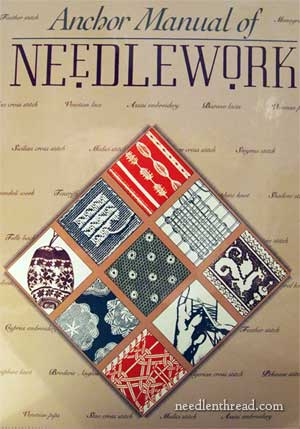
The outside of the books is actually the only place where you’ll see color here! Now, don’t be dismayed – there are plenty of black & white books that are excellent and worthy of consideration! Remember, we live in a world that expects color, and color is much more affordable today than it was when this book was printed! But right off the bat, I thought you should know that it’s printed in black & white, in case that’s a turn-off for you!
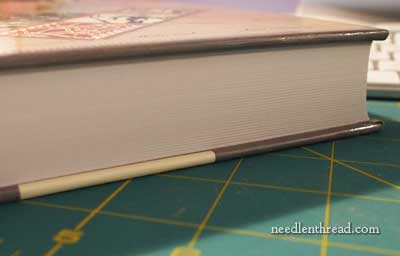
It’s not a small book, either. In fact, as books go, it is a large book! It has a hard cover and is a good 1.25″ thick. It’s a bit on the weighty side. So while this might not be your carry-around stitch dictionary, it is a book worthy of the reference shelf, and it’s definitely a go-to book when you want to look up something about a given needlework technique.
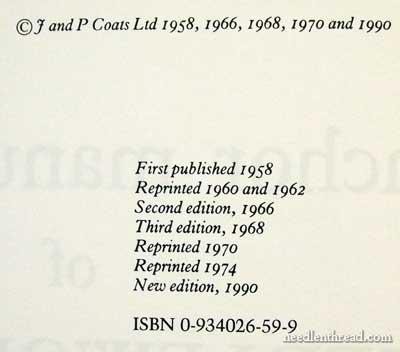
The book, compiled by J&P Coats (same company as Anchor) has undergone several publishings; the most recent edition is printed by Interweave Press.
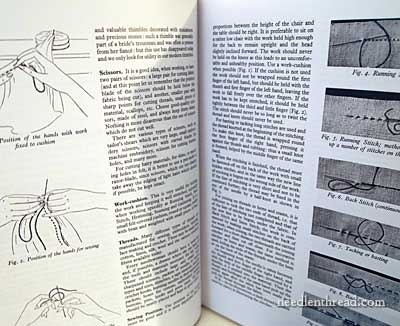
And all that is well and fine, but let’s look at the nitty-gritty: the content! You can see that, as an older instructional book, there is more text and fewer photos than what we’re used to today in instructional books. For me, this is great – I like to read, and I like reading instructions! In fact, I often find that I get more out of reading instructions than I do out of a single photo. Sometimes, the photo doesn’t show everything that the text can explain. So for me, when I’m trying to figure something out, I like having the text to refer to.
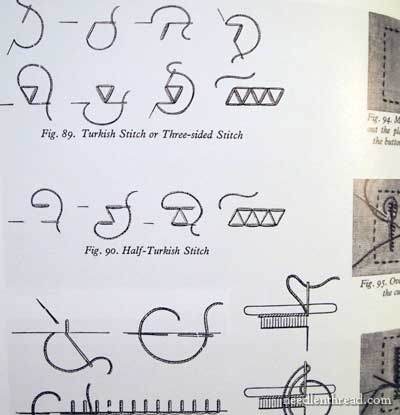
The stitches are illustrated through drawn diagrams, step-by-step. The diagrams are clear and thorough.
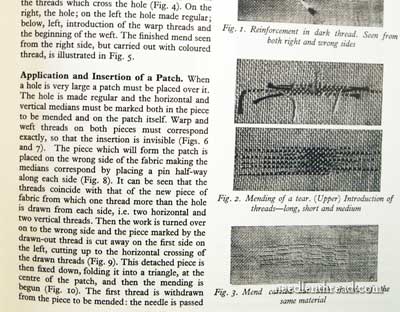
The content of the book is exceedingly thorough. When they say “manual of needlework,” they mean manual of ALL needlework! From surface embroidery to hand sewing to mending and patching, to filet lace to drawn thread to fringed edges and finishing, to sewing with a machine (the basics are all in there!) to goldwork to knitting to crochet…. it’s all in there! This is, in fact, a manual of needlework.
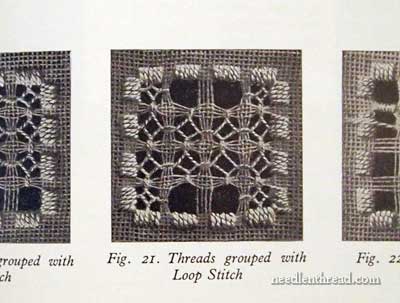
There’s an excellent section on drawn thread work and on Italian needle laces.
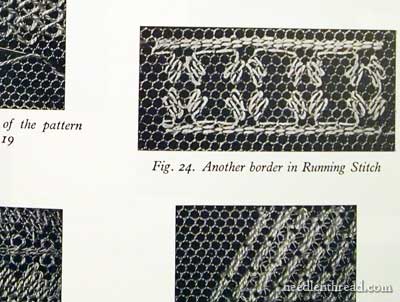
You’ll also find a thorough section on embroidering on tulle. In fact, I used this book for a little piece of embroidered tulle years ago. The instructions are clear and easy to follow.
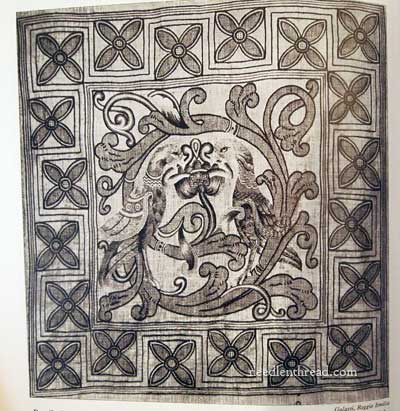
And throughout the book, there are plenty of illustrations of finished pieces, historical needlework, regional techniques, and so forth. The description for the above image reads: “Detail of a rich luncheon cloth in Canusina embroidery. The cloth is divided into many squares, which are repeated around the edge of the cloth, leaving the center of the cloth unworked. The background material is ivory-coloured linen and the embroidery is worked in brown, natural, dark blue, and sea-green.” (Admittedly, it’s descriptions like this that leave me pining for a colored print!)
For a reference book, the Anchor Manual of Needlework is an excellent resource that avid stitchers will want on their bookshelves. As a resource book, I’d give it four out of five stars. It’s definitely worth having. That being said, I don’t think it would be your typical go-to stitch dictionary, as it’s too bulky; there are better and more convenient stitch dictionaries on the market! (ex: Mary Thomas’s Dictionary of Embroidery Stitches; The Embroiderer’s Handbook; Embroidery Stitch Bible, all the A-Z books, etc.)
The nice thing is, you can pick up the Anchor Manual of Needlework through used booksellers for about $5 – $10. Don’t be tricked by sellers who have it on for $90 or more! With a little looking, there are plenty of them out there for less than $10!
So, what do you think? Is this the type of book that interests you? Why or why not? Do you find text-heavy, black & white publications difficult, or do you like them at least for reference? Leave a comment below and let me know your thoughts!







I would definitely want to include the Anchor manual in my reference library. I am mildly dyslexic and when I am working a new technique I go to many books and combine the information to use that works best for me. Your review makes this book one I would consider.
G’day Mary,
The book I have is similar but not nearly as good.
It seems to have all of what yours has but it is lacking in the amount of embroidery stitches it contains. It concentrates on whitework and linen in the embroidery line.
It is a recent reproduction from the originl of 1884! ‘The Complete Encyclopedia of Needlework’ and is a DMC book.
Like yours though, the tulle embroidery is concise and lovely, which attracted me to it in the first place. Besides the ‘old timeness’ of it as well.
Yours is wonderful. I don’t mind text. It’s kind of gets to the nitty gritty and saves me having to try to work it out in my mind which seems to be the way I go.
Thanks for this review. All good.
Cheers, Kath
This is indeed a very interesting book. It looks as an excellent reference and resource book. I am particularly interested in needle lace, and it looks like it has a lot of information about it. A quick look in the internet revealed that you can buy a used copy in a very low cost!
Thanks, I didn’t know this one.
I like this kind os books.I have the “Encyclopédie des Ouvrages de Dames” of Thérèse de Dillmon. (30 euros) and I love it. (sorry about my poor english!!!)
I have had this book on my shelf for years. I really like it! While it is very good for stitch direction, I also enjoy reading about all the various techniques it includes. A very comprehensive “Manual.” Two thumbs up!
I bought a book called EMBROIDERY, the consultant Editor is Pauline Brown. First published in England, in 1986 published in the US and Canada y Random house.
It a wonderful book to have in every library of those that love needlework. Beutiful color photographs of stitching samples. I will post pix in my blog.
Love vintage craft books and magazines! and I
Enjoyed your review. I will keep an eye out for this book–Thank you
Thank you Mary! It is worth trying to hunt down the book. As a former archivist it is my sentiment as well that older black and white print books often offer better descriptions than the newer but prettier colored books. It is a matter of taste. Both have a place in a library.
Monique
I definitely agree that this book is a staple to have in your library. I refer to it all the time (so much so that I’ve ripped the top of the spine paper from pulling it off the shelf so many times) I strongly suspect that this publication was originally Italian for a couple of reasons: the large sections dedicated to Italian embroideries and laces and that most (if not all) the photo credits are Italian. I have two Italian versions of this book, one is a reprint from 2007 of the 4th edition and one is an original 2nd edition both which carry no dates. The clothing and hairstyles of the ladies in the photos tell us the 1950s but I’d love to see a 1st Italian edition anyway to see how it differs. The Italian editions have a bit more history (Italian related) and some different photos than the Anchor Manual in English, a few photos have been “colourized” – remember that technique of colouring parts of black and white photos?
There is a bit of history about the Coats/Anchor company (called Coats Cucirini) in Italy on my blog – I have long wondered about this publication and I think its time that I wrote them to see if they know the history of this book. I’ll keep you posted!
Oh, and Canusina embroidery is fabulous! Check my blog again for Ars Canusina for some links to great colour photos!
I paid only $12.00 usd for the Anchor Manual, 3 ed, 1968. I have had it about 6-7 months and I have not allowed it to be moved from my dining room desk. It was the only published work that I know of that included “Punchetti” , a needle lace, which I want to much to achieve.
It is a gem. Etta J. Liberi
Hi Mary! Hope you are having a great time on your trip. This looks like an interesting reference book that I will have to check out. I find it is good to have several reference books to look at when trying to learn something or figure something out. Must be the researcher in me. That being said, I do learn from reading, but find I am more of a “show me” type of person. Show me once and I have it. If I have to read to fill in the visual gaps I usually have to read through it and refer back to the visual parts for clarification.
Yes! I really will like to have a book like this!!!!
Congratulations I enjoy this link!!!!!
Hi Mary. This book was the first book I bought when I first went out to work after leaving school.I have the 1974 version with the teal cover and it has been everywhere with me ever since.My college teacher Mrs. Saunders had a copy and so I had to get one too.This was when Embroidery was still taught in schools.
Back then in 1975 it had to be imported from Britain and cost $NZ22.45 A third of my weekly wage at the time.
Phillipa from New Zealand
I have to admit I’m a needlework book junkie and find it very hard to pass up ones like this. Black & white or colour makes no difference to me because I’m happy with either.
I have had this book since the 1950’s when I bought it out of a book allowance at college. It has inspired me many times to try a new style of embroidery. For many years, it was the only embroidery book which showed embroidery from other countries. A real treasure for its time and one which is still applicable.
I have just subscribed and I must say that I feel like a ship that has finally found the channel markers to a welcoming shore. I have been working from several of the references you suggest. All alone. Stitching and stitching for reasons I cannot even articulate. For years.
Thank You
Hi Mary,
I love needlework books, and when I’m trying out a new stitch, I like to look it up in different books and compare explanations! So I’d love to have this one, black & white is no problem.
Hope you are enjoying your holiday.
Any book on embroidery (black & white, colour, etc.)interests me. Sometimes we may have used the stitch, but forget how to do it. Having a reference book will help us to recollect how to do a particular stitch. This books seems to have a lot of stitches and in detail. WOW!
HI
I always like books………. and embroidery books is my favorite.
Thanks for letting me know about the book
Vidya
I have it also (and the DMC reprint), it is a nice book. What I like about these (besides excellent directions) is that with so many techniques, you can try a bunch. And if one technique really intrigues you, then you can focus on books about that. Much less expensive than buying a book on a single technique and realizing you are quickly bored with it. They also seem to encourage you to design your own designs, as there are not a lot of patterns in them.
Hi Mary,
I don’t have this book but it will be interesting to locate it. I have the A-Z books.
I love this type of book. I usually find something that is not in the other black and white books.
LB
both texts have their own point of view. It think for a beginner anchor would be the place to go for a thorough knoledge of techniques
Hi Mary, don’t have this publication, but it sure looks like one I’d love to have on my bookshelf. I have a very small Anchor books of stitches, plus a few of the little square ones. I also have the one Velia is talking about [by Pauline Brown] and I find it an excellent source of inspiration. Thanks for this.
I read your letter today and remembered I have the same book in my book case, haven’t looked at in years…thank for reminding me….mine is from 1966 andI got it at a used book store for $1.00
I went to Amazon and they had many used copies at 6.50 so I bought one. Sounds great!
I like the big refernce books for looking at when I am home they seem to explain the stitches better then the little books. Then I use the small books such as Judith Bakers Montano’s Embroidery & Crazy Quilt tool in my travel bag as a reminder reference when I go somewhere that I am embroidering which is almost everywhere.
Karol
I have had this on my bookshelf for longer than I can remember. It is an excellent reference and belongs in every needleworkers library. It has the answer to every question you have about techniques and materials. If you need more information or color photos, once you have the reference from the book you can google for more.
i am very interested in these hand works. pls send new designs 2 my id. it may b a great help.
Quantas vêzes entro no site Agulha e Linha na expectativa de encontrar um novo ponto de bordado ou ainda, uma nova maneira de bordar “um ponto já conhecido”. Mas, o que mais me admira é a forma como a senhora escreve abro o site pelo simples prazer de ler(estou lendo em portugûes tradução do Google). Sou bibliotecária e bordo poucas coisinhas, mas tenho a capacidade de divulgar o seu trabalho para várias artesãs, que nem sempre sabem o que é a Internet. É com gratidão que agradeço o seu talento e a disponibilidade de servir.
Hi,
I just love the designs published in your books, they are very helpful.
Thsnks
I have this book & love it! As a 19th C historic interpreter, I find the instructions for tatting, for instance, invaluable, as modern joinings are quite different.
I wish my embroidery & lace techniques were anywhere near the quality shown.
I highly recommend having this as a reference.
i like to get this book
Where can I order this book ?
I live in India. Can you please provide me with some contact detail so that I can order it.
Thanks.
The more I learn, the more I don’t know. What is the difference between embroderiery , cross stitch, needlepoint, stump work etc.
I checked this book out from the library many years ago (maybe the 70’s and no later than the 80’s). I loved it and I want the version I checked out of the library. It contained Parma Braid, Cavandoli Work, and other little-known techniques. I loved the Anchor Manual of Needlework, and I am going to try to find the edition I read.